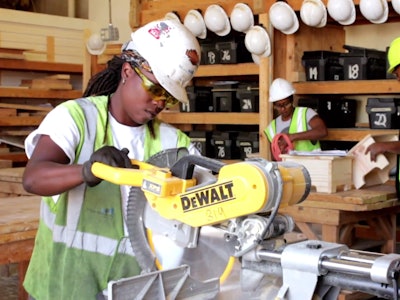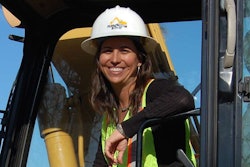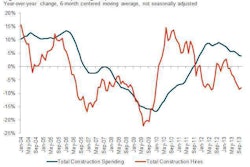 A trainee in the Women Wear Hard Hats Too construction training program in Minneapolis, Minnesota
A trainee in the Women Wear Hard Hats Too construction training program in Minneapolis, MinnesotaRecently, Barbara A. Res penned an insightful column for the Baltimore Sun examining why there are so few women in the construction industry and detailed why and how this should be changed.
As contractors across the U.S. continue battling a skilled worker shortage that is impacting completion dates and ability to meet rising demand, it’s a good idea for these companies to hear Res out. The industry is in no state to be picky and it’s missing out on a lot of great if it continues to operate without a focus of recruiting more women.
Res is an engineer, construction industry executive and layer with 30 years of experience in the industry. She is the author of the memoir All Alone on the 68th Floor: How One Woman Changed the Face of Construction.
In the column, Res cites Bureau of Labor Statistics data that says women make up 9 percent of the construction industry’s workforce in the U.S., most of them either executives or in clerical and secretarial positions. Only 6 percent of the construction workforce is made up of female construction managers and less than 3 percent are on-site laborers.
RELATED: Want to boost your construction business? Put a woman in charge
As to why there are so few women in construction, Res shrugs off the cultural perception that construction work is only for men due to the notion that the work demands brute strength. “Occupational Safety and Health Administration (OSHA) and union rules along with new building technology has made the requirement for strength inapplicable to most trades,” Res writes.
Res argues that the real reason more women haven’t pursued careers in the industry is a lack of protection.
“In construction, harassment, discrimination and intimidation are still deterrents to women entering the business,” she writes. “…A general bias against women working with tools still exists. Many men in the trades oppose women working and do what they can to discourage them. So much so that even women who enter the field often drop out due to the failure of society to accept them in their roles and the pervasive harassment and stereotyping that remains in the business.”
To correct this, Res recommends points to what helped in other professions such as law enforcement: “mandatory participation and laws against discrimination.”
In those fields, Res points out how women were pursued and recruited to fill “reasonable quotas” using “women-focused apprenticeships and incentivized training programs.”
On top of more focused recruiting of women, those fields filled their quotas because they were able to prove that women could be assured they would be protected from discrimination and harassment once they signed on, Res writes.
“Better enforcement of existing laws might improve this. Right now, companies just monitor themselves. If there were a presence on construction sites rooting out intimidation and harassment like OSHA does supervising safety, it would eliminate the hostile environment in which many women are forced to work,” she writes. “A staggering 88 percent of women in the trades report being harassed, but most do not complain for lack of response and fear of retaliation. Women lay low and try to do their jobs. Loneliness and isolation are other reasons to leave.”
We’ve seen two women-focused training camps so far. There’s the Women Wear Hard Hats Too training program in Minneapolis, Minnesota (which has a 90 percent job placement rate) and the Rosie’s Girls camp in Cincinnati, Ohio.












